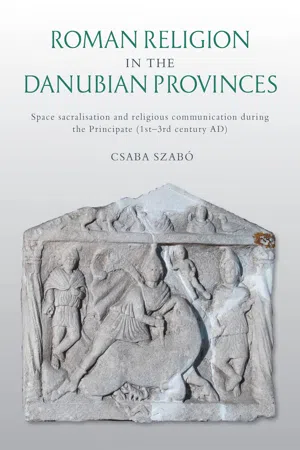
Roman Religion in the Danubian Provinces
Space Sacralisation and Religious Communication During the Principate (1st–3rd Century AD)
- 240 pages
- English
- ePUB (mobile friendly)
- Available on iOS & Android
Roman Religion in the Danubian Provinces
Space Sacralisation and Religious Communication During the Principate (1st–3rd Century AD)
About This Book
The Danubian provinces represent one of the largest macro-units within the Roman Empire, with a large and rich heritage of Roman material evidence. Although the notion itself is a modern 18th-century creation, this region represents a unique area, where the dominant, pre-Roman cultures (Celtic, Illyrian, Hellenistic, Thracian) are interconnected within the new administrative, economic and cultural units of Roman cities, provinces and extra-provincial networks. This book presents the material evidence of Roman religion in the Danubian provinces through a new, paradigmatic methodology, focusing not only on the traditional urban and provincial units of the Roman Empire, but on a new space taxonomy. Roman religion and its sacralized places are presented in macro-, meso- and micro-spaces of a dynamic empire, which shaped Roman religion in the 1st-3rd centuries AD and created a large number of religious glocalizations and appropriations in Raetia, Noricum, Pannonia Superior, Pannonia Inferior, Moesia Superior, Moesia Inferior and Dacia. Combining the methodological approaches of Roman provincial archaeology and religious studies, this work intends to provoke a dialogue between disciplines rarely used together in central-east Europe and beyond. The material evidence of Roman religion is interpreted here as a dynamic agent in religious communication, shaped by macro-spaces, extra-provincial routes, commercial networks, but also by the formation and constant dynamics of small group religions interconnected within this region through human and material mobilities. The book will also present for the first time a comprehensive list of sacralized spaces and divinities in the Danubian provinces.
Frequently asked questions
Information
Table of contents
- Front Cover
- Half-Title Page
- Title Page
- Copyright Page
- Contents
- List of illustrations
- List of abbreviations
- Foreword
- 1. Introduction
- 2. Emerging Roman religion: the beginnings
- 3. Lived religion and its macro-spaces in the Danubian provinces
- 4. Space sacralisation in meso-spaces
- 5. Religious experience in micro-spaces: housing the gods
- 6. Conclusion: beyond the materiality of Roman religious communication
- Appendices
- Bibliography